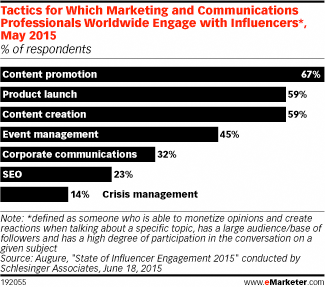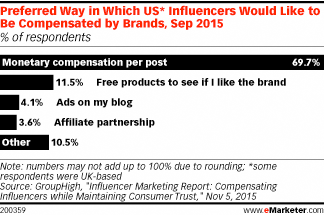Influencer Marketing Is Rapidly Gaining Popularity Among Brand Marketers
February 10, 2016
![]() As concerns about ad blocking grow, influencer marketing is becoming more important to brands. YouTube, Instagram and Snapchat have become popular channels, and new tools are making it easier to work with influencers, as explored in a new eMarketer report, “Influencer Marketing for US Brands: The Platforms to Watch, and the Best Ways to Work with Creators.”
As concerns about ad blocking grow, influencer marketing is becoming more important to brands. YouTube, Instagram and Snapchat have become popular channels, and new tools are making it easier to work with influencers, as explored in a new eMarketer report, “Influencer Marketing for US Brands: The Platforms to Watch, and the Best Ways to Work with Creators.”
 Digital agency executives also report rising interest in influencer marketing among their clients.
Digital agency executives also report rising interest in influencer marketing among their clients.
“Influencers are such an important part of what brands are doing today,” said Greg Manago, co-president of content and entertainment for North America at Mindshare. “The question [from clients] isn’t, ‘We want to do something with influencers; what do you think?’ It’s, ‘What’s the influencer strategy for this program?’”
 According to Altimeter Group’s “State of Social Business” study, 35% of social media professionals polled in Q2 2015 considered their use of influencer marketing to be at a mature stage, and only 14% had no plans to use it as part of their social strategy.
According to Altimeter Group’s “State of Social Business” study, 35% of social media professionals polled in Q2 2015 considered their use of influencer marketing to be at a mature stage, and only 14% had no plans to use it as part of their social strategy.
And the need for video content is a major driver. “We continue to look for partners and influencers that can help us create some of these unique pieces of content,” said Josh Martin, director of digital and social media at fast-food chain Arby’s. “It’s not just taking 10 seconds out of a 30-second spot and slapping it on Facebook.”
In the past, working with influencers was time-consuming. Brands had to find and vet individual bloggers, strike deals with them and then devote significant resources to managing campaigns.
Now, there are an increasing number of talent agencies, networks and matchmaking services for influencer marketing. Some have been acquired by larger companies, such as Maker Studios (acquired by The Walt Disney Co. in March 2014) and Niche (acquired by Twitter in February 2015).
While there are no firm estimates of the size of the influencer marketing business, there are several signs that US marketers are spending more money on it. Augure’s study found that 61% of US marketers planned to increase influencer marketing budgets in 2015. This was a significantly greater percentage than in Europe, where 20% of respondents expected increases.
In addition, more influencers want to be paid in cash: In other words, they have become less willing to take compensation in the form of products or trips.
“When it started out, it was all unpaid, because people viewed it as more PR-focused than media-focused,” said Rustin Banks, co-founder and chief product officer at influencer marketing firm TapInfluence. Now, “each of these influencers is a media channel, and media channels need to be compensated.”
Influencers surveyed in September 2015 by GroupHigh, a blogger and influencer marketing firm, overwhelmingly preferred monetary compensation over free products, ads on their blog or affiliate deals.
Courtesy of eMarketer































